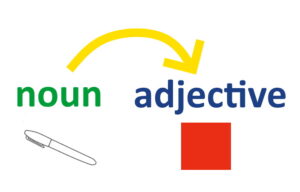This page outlines how adjectives are used in Brazilian Portuguese.
Adjectives describe things and tell us more about the noun. If you can put ‘it is’ in front of a word, then it’s most probably an adjective.
The adjective in Portuguese normally comes after the noun, this is the opposite word order to English (e.g. caneta vermelha / pen red)

The ending of the adjective changes depending on the noun it follows. Portuguese adjectives have to “agree” with the noun they are describing – if the noun is masculine, then the adjective will probably end in an o. If the noun is feminine, then the adjective will probably end in an a:
- ele é baixo / he is short
- a cadeira é amarela / the chair is yellow
The word for ‘good’ changes depending on whether it is masculine, or feminine:
- bom = good (m) – e.g. o peixe é bom / the fish is good
- boa = good (f) – e.g. a pizza é boa / the pizza is good
Some adjectives are neutral and stay the same for both masculine and feminine nouns. These adjectives often end in e rather than o and a (e.g. intelligente and grande)
If the noun is plural, add an s to the end of the adjective (e.g. gatos pequenos / small cats)
See below for a list of adjectives in Brazilian Portuguese:
| tall | alto |
| short | baixo |
| short (length) | curto |
| long | comprido |
| small | pequeno |
| big | grande |
| easy | fácil |
| difficult | difícil |
| fun/funny | divertido |
| annoying/boring | chato |
| fat | gordo |
| thin | magro |
| young | jovem |
| old | velho |
| 👈 Previous page | Next page 👉 |
| Countries and nationalities | Colours |
